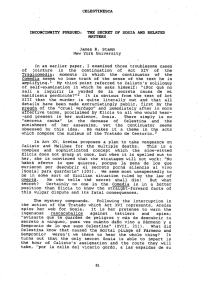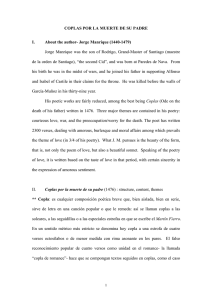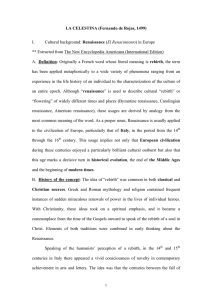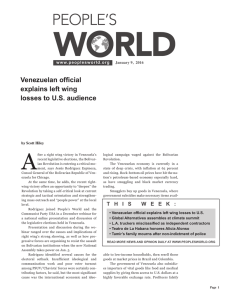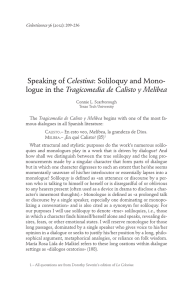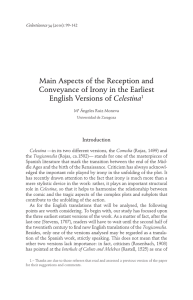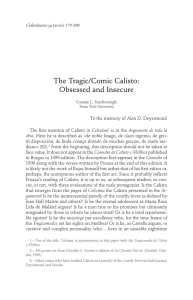Sears - Parnaseo
Anuncio
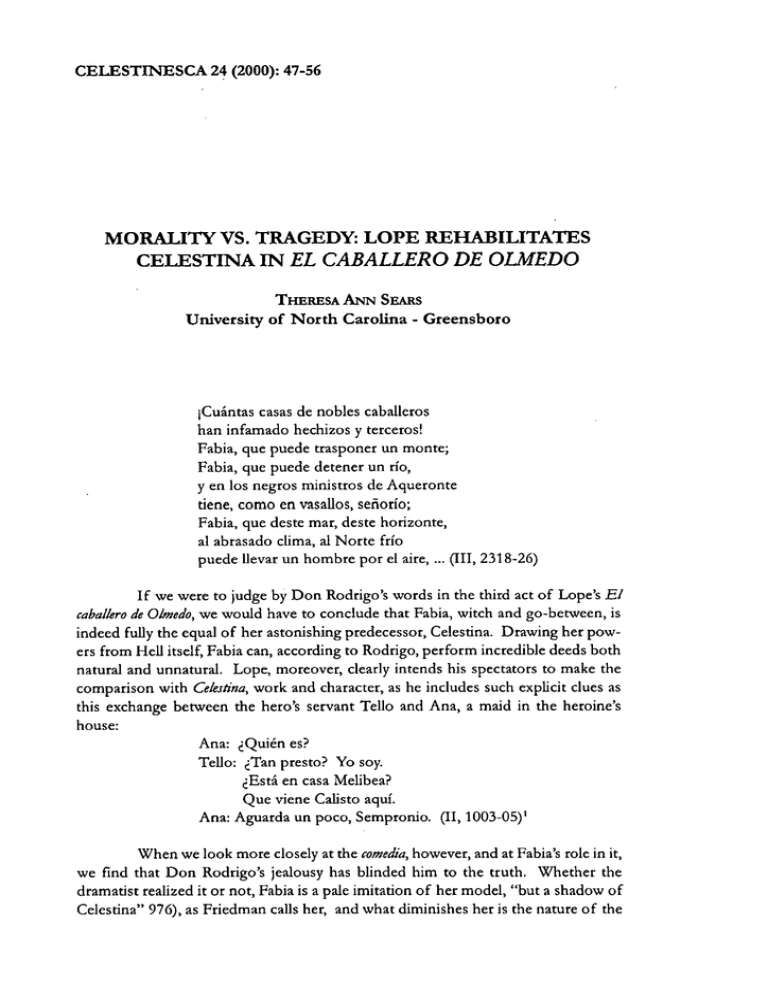
CELESTINESCA 24 (2000): 47-56
MORALITY VS. TRAGEDY: LOPE REHABILITATES
CELESTINA IN EL CABALLERO DE OLMEDO
THERE~A
ANN SEARS
University of North Carolina - Greensboro
iCuintas casas de nobles caballeros
han infamado hechizos y terceros!
Fabia, que puede trasponer un monte;
Fabia, que puede detener un rio,
y en 10s negros ministros de Aqueronte
tiene, como en vasallos, seiiorio;
Fabia, que deste mar, deste horizonte,
a1 abrasado clima, a1 Norte frio
puede llevar un hombre por el aire, ... (III, 2318-26)
If we were to judge by Don Rodrigo's words in the third act of Lope's E/
caba//ero de Ohedo, we would have to conclude that Fabia, witch and go-between, is
indeed fully the equal of her astonishing predecessor, Celestina. Drawing her powers from Hell itself, Fabia can, according to Rodrigo, perform incredible deeds both
natural and unnatural. Lope, moreover, clearly intends his spectators to make the
comparison with Celedna, work and character, as he includes such explicit clues as
this exchange between the hero's servant Tello and Ana, a maid in the heroine's
house:
Ana: 2QuiCn es?
Tello: ?Tan presto? Yo soy.
2Estb en casa Melibea?
Que viene Calisto aqui.
Ana: Aguarda un poco, Sempronio. (II, 1003-05)'
When we look more closely at the comedia, however, and at Fabia's role in it,
we find that Don Rodrigo's jealousy has blinded him to the truth. Whether the
dramatist realized it or not, Fabia is a pale imitation of her model, "but a shadow of
Celestina" 976), as Friedman calls her, and what diminishes her is the nature of the
48
THERESA ANN SEARS
work in which she appear^.^
Celestina, needless to say, is one of Spanish literature's greatest creations,
but hers is a dark glory. Mercenary to her very soul, Celestina defines herself by
greed, as when Sempronio proposes using Calisto's desire for Melibea for financial
gain: "Digo que me alegro de estas nuevas, como 10s cirujanos de 10s descalabrados"
(58). She is cold-hearted enough to laugh as she sends others to death and eternal
damnation. Although presented as a bruja, Celestina is a witch whose foremost power
lies in the force of her personality, not in her infernal skills. Although Melibea's first
response to Celestina's request that she take pity on Calisto is as harsh as her reaction to Calisto himself (she declares: 'Tor cierto, si no mirase a mi honestidad y por
no publicar su osadia de ese atrevido, yo te hiciera, malvada, que tu razon y vida
acabaran en un tiempo." [95]), Celestina's feigned humility and description of Calisto's
attractions and his suffering soon win the girl over. In the end, she cheerfully sacrifices even those for whom she professes some small amount of affection to her
over-riding self-interest.' This we can see in her treatment of Arebsa, whom she has
promised to Pirmeno as a reward for participating in the scam. The prostitute
argues that "tengo a quien dar cuenta . . . y si soy sentida, matarme ha[.] Tengo
vecinas envidiosas. Luego
10 dirin" (129), but Celestina will not be denied and
Are6sa inevitably capitulates, saying: "Que mis quiero tener a ti contenta, que no a
mi; antes me quebrart un ojo que enojarte" (132).
Celestina is, in a word, a monster, in the etymological sense of a warning.
Her presence in the lives of two young nobles symbolizes their descent into immorality and crime. Rojas has no illusions about love, and none of his characters is
either innocent or honorable. Whether it is for money or sex, they all lust, and they
all barter their souls to acquire that for which they lust. In the relentless logic of
Rojas's pitiless moral message, all of his characters get what they want, and they all
get what they deserve. Each is responsible for his or her own fate and no one gets
out alive. Even Melibea's parents are punished by the loss of their daughter for their
carelessness in allowing a woman of Celestina's reputation into their respectable
house, for failing to ward their daughter more carefully and to arrange a timely and
appropriate marriage, and in the father's case, for his own amorous adventures as a
young mans4
Lope de Vega's Elcabaflero a'e Olmea'o is something entirely different, a poetic minuet of a tragedy that cannot compare in terms of moral vision or dark
grandeur with Cebshnds sweeping disaster.' When the comedia begins, the hero Don
Alonso tells us that, in contrast to the harsh rejection that sends Calisto plunging
into black despair, he has hope that his love may be requited:
No me miraron [i. e. 10s ojos] altivos;
antes, con duke mudanza,
que, con poca diferencia,
LOPE REHABILITATES CELESTINA
49
pensando correspondencia,
engendra amor esperanza. (I, 15-20)
He meets Fabia immediately, tells her his problem, and when she comments
"Alto has picado" (71), responds: "Es deseo de su honor" (72). In this way, Cabalhtv
establishes its principal underlying difference from Ceh~tina:Don Alonso's love never
desires anything but marriage to the lady, Inks. Fabia, moreover, believes him ("Asi
10 creo" [73]), and agrees with his assessment of Inis, whose festival disguise could
not obscure "el ser tan hermosa y bella" (66), in Fabia's words. Absent is Celestina's
persistent cynicism, which expresses itself, for example, in her plans for Pirmeno:
"Harile haber a Are6sa. Seri de 10s nuestros; darnos ha lugar a tender las redes sin
embarazo por aquellas doblas de Calisto" (82). Instead, Fabia responds with apparent sincerity, moved by the story of Alonso's love:
Tello, con industria, igual
pondrk el papel en su mano,
aunque me cueste la vida,
sin inter&, porque entiendas
que, donde hay tan altas prendas,
sola yo fuera atrevida. (I, 189-94)
Moreover, when Alonso launches into the story of how he came to fall in
love, his description of Inis conforms to Neoplatonic ideals, in contrast to Calisto's
rapid descent into intimate particulars concerning Melibea's body. The most erotic
thing that Alonso mentions is the ribbon that ties Inis's shoes:
N o pensaron las chinelas
llevar de cuan'tos la miran
10s ojos en 10s listones,
las almas en las virillas. (I,107-10).
,
In the place of Calisto's sexual obsession, Alonso twice insists on his honorable intentions. First, following Inks and her sister into a chapel, he says "entrk
imaginando bodas" (153). Then, although he promises Fabia the same "cadena
rica" (180) that Calisto gives to Celestina," Alonso sets for her a very different task
for which it will serve as a reward:
(...) si quieres
ser dichosa y atrevida
hasta ponerle [i. e. una carta] en sus manos,
para que mi fe consiga
esperanzas de casarme
173-78)
,
(tan en esto amor me inclina) ... (I
50
THERESA ANN SEARS
Although Lope gestures in the direction of darkness,.the references consist
largely of Tello's rather comic fear of Fabia's supposedly supernatural powers, as
when she insists that he accompany her to fetch a molar from a hanged man to use
in her magic. Declaring that she "enseiiada estin / a hablar a1 diablo" (I, 608-g),
Tello asserts:
Mindame a diez hombres juntos
temerario acuchillar,
y no me mandes tratar
en materia de difuntos. (610-14)
Such references, however, cannot negate the essential innocuousness of the
situation: a wholly admirable and profoundly nice young man wants to marry a beautiful girl.
When the comedia changes its focus to Ints, the play reveals another element that softens Fabia's character compared to Celestina. For whereas Calisto
hires Celestina to effect the seduction that he was unable to carry out before Melibea
tossed him out of her garden, Inis's first words reveal that she has already fallen in
love with Alonso:
(...) en el instante que vi
este galkn forastero
me dijo el alma "Cste quiero",
y yo le dije "sea ansi". (I,223-26)
Thus, in spite of Lope's care in establishing Fabia's credentials in witchcraft
(in fact, we see more of the mechanics in the comedia than in Celeslind), she never has
to use any of her more unsavory skills in her role as go-between. In fact, that is all
Fabia does: she goes between Alonso and Inis, carrying messages of mutual love,
admiration, and respect. She does not convince, persuade, or seduce, as Rojas portrays Celestina doing." Although Fabia does employ the rather transparent ruse of
claiming that the letter is for another lady, to whom she is too frightened to deliver
it, she deceives no one, as Inks says:
Sospecho .
que es invenci6n que se ha hecho,
para probarme a rendir,
496-99)
,
de parte del forastero. (I
Her sister Leonor also sees through the deception: "Yo tambien 10 imagini"
(500). The love between Alonso and Inis, then, becomes the natural feeling that
both name it at various times during the play, and not the unnatural, febrile desire
called forth by Celestina's masterful voice. Alonso and Inis seem to be speaking
LOPE REHABILITATES CELESTINA
51
directly to one another, even when they are not face to face, and Fabia's office is less
a necessity than a convention.
This brings us to a key point that distinguishes Elcabaflero de Ohedo from
Celedna: the attitude that the work expresses toward love. Love in Cek~tinais sexual
desire-lust-and
it is nothing else. The story means to warn readers against love,
as the opening and closing verses declare:
0 damas, matronas, mancebos, casados,
Notad bien la vida que aqukstos hicieron,
Tened por espejo su fin cuil hobieron:
A otros que amores dad vuestros cuidados.
Limpiad ya 10s ojos, 10s ciegos errados,
Virtudes sembrando con casto vivir,
A todo correr debkis de huir,
N o OS lance Cupido sus tiros dorados. (Cehtina 40)
Written for readers who may have been entranced by the noveh sentimental:
Celedna strips the illusions from idealized love in order to show what lies behind
them, as well as the ruin that results when men and women surrender to love. E f
caballero de Olmedo, on the other hand, exalts love, endorsing the Neoplatonic idealization of "true" love. Although some might argue that Alonso sins in that he employs a witch to further his love,"' the emotion itself as he feels it is never questioned or criticized. Instead, it is shown as a force that takes root only in the noblest
of souls. Fabia tells Inks that Alonso is:
Del m6s noble, Del m6s cuerdo
caballero de Castilla,
lindo talle, lindo ingenio.
El Rey en Valladolid
grandes mercedes le ha hecho,
porque kl solo honr6 las fiestas
de su real casamiento. (I, 848-54)
Although Celestina similarly eulogizes Calisto to Melibea, she never mentions
either the opinion that others in society have of him or his intelligence, which suggests yet again that the play sees love as something that is consistent with, rather
than a radical subversion of, the hero's character. Alonso's idealized love also further ennobles him ,as we see in his gallant rescue of Don Rodrigo, his rival for Inks's
hand, during the third-act festivities.
True love, in addition, only seeks honor for the beloved. Compared to
Calisto's relentless momentum towards sexual intercourse, one which cannot entirely avoid the charge of rape, Alonso is content to write to Inks and speak with her
52
THERESA ANN SEARS
through the r+. Even Melibea's corddn which carries such a powerful sexual message
in Cehstina becomes a ribbon that, divided in G o , loses all connection with Inis
when Rodrigo and Fernando come upon it. Unable to decide whether Inis left it for
Rodrigo or her sister Leonor left it for Fernando, each takes half: "A que las dos nos
659-61).
,
Since
le vean, / y sabrin con esta traza / que habemos venido juntos" (I
the audience knows that it was really left for Alonso, the sight of Rodrigo andFemando
marching off displaying the love token of they do not know whom provides comic
relief in a play that insistently warns of the tragedy to come." When Alonso ends
up with Rodrigo's cloak after an encounter in the dark, it symbolically confirms what
everyone knows, and what Rodrigo will not accept: the gallant outsider has taken the
place in Inis's heart that Rodrigo had hoped to win for himself.
The presence of Rodrigo and Fernando, furthermore, also contributes to
Fabia's lack of malevolent influence in the comedia. While the Celestna portrays
Calisto's desire as something singular, isolated, culpable and therefore subject to
punishment by implacable divine justice, Alonso's love is one in a world of love. His
love does not outrage the universe; it only outrages Rodrigo, who kills out of frustrated, jealous self-interest. In fact, Rodrigo's act-and its motivation-are much
more similar to the attack on Celestina by Calisto's servants, Sempronio and Pirmeno,
who want a piece of the gold chain paid to Celestina by Calisto. Rodrigo hates
Alonso because he has earned a prize that Rodrigo himself could not, and because
no one doubts that Alonso has earned it fairly and deserves it. He himself admits:
Su dueiio es don Alonso, aquel de Olmedo,
alanceador galin y cortesano,
de q4en hombres y toros tienen miedo.
Pues si tste sirve a Inis, iqut intento en vano?
0 @m0 quiero yo, si ya le adora,
que Ints me mire que semblante humano? (11,1351-56)
Even Inks's father, once he finds out that her feigned intention to become a
nun arose out of her love for Alonso, exclaims "'Albricias hubiera dado" (111,2565)
and quickly repudiates his choice of Rodrigo:
Desde agora es tu marido;
que me tendri por honrado
de un yerno tan estimado,
tan rico y tan bien nacido. (2581-84)
In spite of Alonso's gullty remorse as he dies, and in spite of critics who have
tried to find a flaw in Alonso,lz there is no similarity between Calisto's death and
Alonso's, except that both are ugly. Calisto perishes, broken and unshriven, in a
stupid accident. Alonso falls victim to a vicious murder plot planned by a jealous
rival, but his death nevertheless further ennobles him, as Tello tells the king:
LOPE REHABILITATES CELESTINA
53
Cubri6 de luto su casa
y su patria, cuyo entierro
set6 el del fknix, seiior,
desputs de muerto viviendo
en las lenguas de la fama (111, 2701-05)
He lives long enough, that is, to confess and take leave of his parents and loyal
servant Tello. And to tell the story of his death.
The tale of Alonso's murder becomes the final element that reduces Fabia
to little more than an amusing flourish in Elcaballero de Olmedo. Alonso's love comes
into being, flowers, and is cruelly cut off in a well-delineated social structure completely absent in Cebstina. Calisto's isolation, however we explain it," allows in part
the dangerous solipsism of his desire. Alonso, in contrast, although he is an "outsider," according to the song that informs Lope's play,I4 is a recognized member of
aristocratic society. The king, we find out early on, knows him and honors'him. His
skills as a nobleman and his personal integrity are universally acknowledged. He has
parents, and it is his concern for their peace of mind that leads to his death. Most
significantly, the structures of authority that such a social system implies come together to pass judgement on Alonso's murderers. When Tello identifies Rodrigo
and Fernando as the guilty parties, the king declares: "Prendedlos, / y en un teatro
maiiana / cortad sus infames cuellos" (111,2728-30). The same society, the values
of which Alonso upheld in his chaste courtship of Inis, allow her, as well, a fate
that, while certainly sad and ironic, is far more seemly than that allotted to Melibea
in Celedna. Instead of a sloppy, unsanctified suicide, Ints retires to a convent, converting her ruse into truth.
When we look at the elements that we have identified as those which work
to reduce Fabia's role in the comedia when it is compared to that of Celestinamutual love; true, idealized love meant to end in marriage; the displacement of the
culpability for the hero's death onto a jealous rival; and the presence and judgement
of society-we find that we have the contributing aspects of tragedy. Whereas
Cekstina exists to teach a moral lesson, tragedy, as Mason has argued, "lies byond
good and evil" (24). In tragedy, as in Elcaballero de Olmedo,we find "the impossibility
of distinguishing the guilt from the innocence of the tragic hero" (83), while in
Cekstina it is made clear that eveyone is g d t y and so all are punished. All of the
warnings that Alonso receives, the uneasy dreams and mysterious apparitions, cannot turn him from his path because, in the first place, that path is part of his everyday life, which he cannot believe could hold something fatal to him.'' At the same
time, they contribute to the tragedy, in which "the final event seems to have been
inevitable" (96).16 Indeed, as Dollimore argues in his recent Death, Desire, andLoss in
WeJtern Cdtz~re(1998), tragedy plays out the "paradox" that "even as we are driven
forward by a secular fear of failure, we resort to the metaphysical reassurance that
54
THERESA ANN SEARS
such failure is ultimately inevitable" (xviii). Celestina and those whose lives intersect
fatally with hers gain their just rewards for the immoral choices that they make, and
not because destiny caught them on the wrong road at the wrong time. Finally,
tragedy always involves the bonds that hold society together, and the hero's death
must move the society that surrounds him." Not only Inks mourns Alonso; not
only Tello feels his lack. Alonso's parents, his beloved's father, his king and the
king's condestabh, eventually, with the executions of the murderers, all of society will
be affected by the hero's death in ways that confirm the values which he exemplified.
Although Cabalhro is considered a major work in the canon of Lope's
comedias, it is not the strongest of his plays, or even of his tragedies. Part of the
problem no doubt lies with its source; although the use of popular ballads as the
basis for comedias was common and could produce admirable results (only consider
Periba'Ke~elComendadorde OcaKa), in this case the results are unsatisfying. The characters remain largely opaque, and the attempt to "open" them up fails, just as so
many efforts to move theatrical pieces to film in our own day do. The play does not
manage to make the characters' motivations credible, creating such anomalies as a
worthy nobleman, whose only sin is to follow the appropriate channels for courtship
and marriage, who becomes, by Act 111, a vicious and dishonorable highway murderer." It also reduces Celestina to a standard busybody whose references to witchcraft are no more convincing than the hero's commitment to his family, which supposedly sets him on the road to Olmedo so that his rival can eliminate him. When
fate is the enemy of love, and love is seen as good and desirable, then it is fate, not
love, which destroys the hero. A Celestina allied with the good becomes a Celestina
rehabilitated, which is to say, no Celestina at all. The Caballero de Olmdo would meet
his fate, with or without his Celestina. Without his, Calisto stays in bed, Melibea
remains a virgin, and literature loses a powerful metaphor for moral ruin.
NOTES
'
Other clues are rhetorical. Rodrigo's description of Fabia's supposed powers
echoes those that Sempronio and Pirmeno give in Ccfestina,albeit significantly edited to
eliminate the references to the sexual. Alonso's own greeting of Fabia in Act I (''iOh
Fabia, oh reuato, oh copia /de cuanto naturaleza / pus0 en ingenio mortal!") deliberately recalls Calisto's similar effusions upon meeting Celestina: "iOh vejez virtuosa! iOh
gloriosa esperanza de mi deseado fin! iOh fin de mi deleitosa esperanza! iOh salud de
mi pasibn, reparo de mi tormento, regeneraci6n mia, vivification de mi vida, resurrecci6n
de mi muerte!" (64).
Friedman also calls her "a sinister consort and marker of Don Alonso's dark
side," but this contradicts her actual role in the play.
It is curious that even Celestina's fans seem compelled to lessen her grandeur in
'
LOPE REHABILITATES CELESTINA
55
the interest of making her more "user friendly." Gerstinger is an example. He claims
that Rojas made her "not only the chief character of the work but actually its heroine.
(...) But Celestina is only relatively wicked. She is a solicitous housemother to her prostitutes. To Calisto she is a light in his despair, a resurrection from death" (71). To believe
this is to be totally impervious to Rojas's corrosive irony and his moral purpose.
1 am grateful for Patricia Kenworthy's question on this point, which led me to
clarify the parents' culpability. It is interesting to note that Fabia herself comments on
the father's responsibility to arrange his daughters' marriage: "Padre que se duerme en
,
esto, / mucho a si mismo se agravia" (I313-14).
McKendrick paints the play in darker terms: "Lope conceived of passion as an
irresistible force which carried within itself the seeds of its own destruction. Here he
allows those seeds to flower" (103). She concludes that it is "tragic poetic drama" (104105).
6Another sign of the lower profile of moral culpability in the drama is the chain's
destiny. It simply dis'appears as the fated tragedy gathers momentum, instead of becoming a major player in the elaboration of the disaster, as it does in Ceh~tina.
'For example, as mentioned above, Fabia compels Tello to accompany her to
fetch "una muela (...) del salteador que ahorcaron / ayer" (Acto I).
"Fedman makes this point as well: "Fabia has little need for the rhetorical skills
of Trotaconventos o r Celestina" (75).
'These include works such as Diego de San Pedro's Cdrcelde amor.
"'McKendrick comments: "he guiltily protests that his love was directed towards
marriage but he has not, alas, behaved as if it were" (103). Fox recalls: "A. A. Parker
blames the sad conclusion on the imprudence of the two lovers" (9); while Friedman
asserts: "While their love is genuine, they resort to posturing and to role-playing, and this
eventually costs them a happy ending" (75).
l ' Friedman calls the play "the text most obviously concerned with signs" (74),
but passes over the ribbon as serving merely to "set the stage" for Rodrigo "to act upon
his jealousy and rage" (76).
I Z McKendrick argues: "Alonso dies in a sense because he is an anachronism, at
once too reckless and too guileless to survive in a world that no longer conducts itself
(...) in accord with the chivalric code of honourable conduct" (103). For Friedman,
Alonso is "a dehumanized-that is, 'poeticized'-character, dashing, articulate, and heroic in a literary sense" (78). Other believe that he is intellectually arrogant, in that "he
ignores signs and warnings of trouble and insists on proceeding home to Olmedo despite the danger" (Fox 9). For Hesse, "Aunque sabe que puede tomar las medidas
apropriadas para contrarrestar la situaci6n explosiva, el temor bajo el influjo de una
imaginaci6n ingobernable le ha vuelto inm6vil" (31).
I3While it seems most likely that Calisto's desire itself is what causes him to
withdraw from society, other explanations have included the assertion that his isolation
is a reflection of the status of the upper caste conversos who were being progressively shut
out of the influential positions that they had held in government by the policies of
Isabella and Fernando.
I4This is perhaps the least convincing element of the story when it is extended
from popular ballad t o drama. Medina and Olmedo are only 20 kilometers apart, which
even in the late Middle Ages did not represent an isolating or insurmountable distance.
56
THERESA ANN SEARS
See Mason: "For the incommensurable to erupt with tragic intensity there must
exist a peaceful mode of life in which the hero was managing quite nicely, thank you"
(66).
I6This is, in part, what Friedman means when he declares: "Don Alonso lives in
order to die. Don Rodrigo lives in order to kill" (76).
"Mason explains that in Greek tragedy, such as Antigone, "Time (...) is (...) a relational or situational word. It tells you about the rights and duties of all people in a bond.
Each man looked to obtain it from his fellow-men. The gods exacted it from mortals
and occasionally paid it to mortals. Time was always known to be present by some
external act. It could therefore be measured both by the givers and by the receivers, and
society could look on and estimate whether it was being justly exacted and paid" (55).
'"Friedman argues that it is possible to regard Rodrigo as "the most 'human' of
the characters, the very personification of ardor, jealousy, and fury" (78). He can certainly be considered the most modern of the play's main characters, with an almost
neurotic insecurity from the very beginning that may explain Inks's lack of interest.
l5
WORKS CITED
Dollimore, Jonathan. Death, Desire a n d h in Western Culhre. New York: Routledge,
1998.
Fox, Dian. "History, Tragedy, and the Ballad Tradition in El caballero de Olmedo." The
GoMenAge Comedia: Text, Theory, andPetformance. Ed. Charles Ganelin and Howard
Mancing. West Lafayette, IN: Purdue University Press, 1994. 9-23.
Friedman, Edward H. "Theater Semiotics and Lope de Vega's Elcaba/lero de Olmedo."
El arte de estudiar comedim Literary Theoty and Spanish Golden Age Drama. Ed. Barbara Simerka. Lewisburg: Bucknell University Press, 1996. 66-85.
Gerstinger, Heinz. Lope de V i a and Spanish Drama. Trans. Samuel R. Rosebaum.
New York: Frederick Ungar, 1974.
Hesse, Everett W. Andin> e interpretacidn de h comedia. Madrid: Castalia, 1968.
Mason, H. A. The TragicPlane. Oxford: Clarendon, 1985.
McKendrick, Melveena. Theatre in Spain 1490-1700. New York: Cambridge UP,
1989.
Rojas, Fernando de. La Celedna; Tragt'comedia de Cakstoy Mekbea. Ed. Dorothy S.
Severin. Madrid: Alianza, 1989.
Vega y Carpio, Lope Fklix de. El caballero de Olmedo. Ed. Maria Grazia Profeti.
Madrid: Alhambra, 1981.
